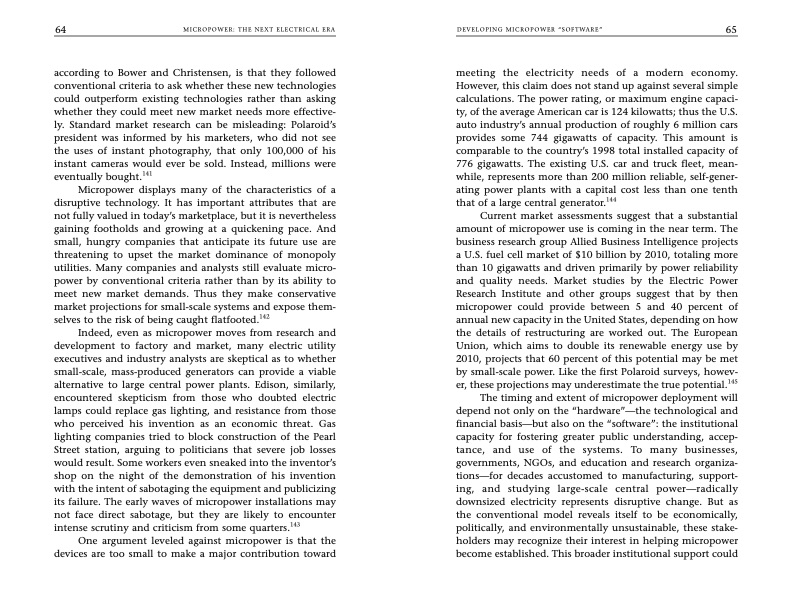
PDF Publication Title:
Text from PDF Page: 033
64 MICROPOWER: THE NEXT ELECTRICAL ERA DEVELOPING MICROPOWER “SOFTWARE” 65 according to Bower and Christensen, is that they followed conventional criteria to ask whether these new technologies could outperform existing technologies rather than asking whether they could meet new market needs more effective- ly. Standard market research can be misleading: Polaroid’s president was informed by his marketers, who did not see the uses of instant photography, that only 100,000 of his instant cameras would ever be sold. Instead, millions were eventually bought.141 Micropower displays many of the characteristics of a disruptive technology. It has important attributes that are not fully valued in today’s marketplace, but it is nevertheless gaining footholds and growing at a quickening pace. And small, hungry companies that anticipate its future use are threatening to upset the market dominance of monopoly utilities. Many companies and analysts still evaluate micro- power by conventional criteria rather than by its ability to meet new market demands. Thus they make conservative market projections for small-scale systems and expose them- selves to the risk of being caught flatfooted.142 Indeed, even as micropower moves from research and development to factory and market, many electric utility executives and industry analysts are skeptical as to whether small-scale, mass-produced generators can provide a viable alternative to large central power plants. Edison, similarly, encountered skepticism from those who doubted electric lamps could replace gas lighting, and resistance from those who perceived his invention as an economic threat. Gas lighting companies tried to block construction of the Pearl Street station, arguing to politicians that severe job losses would result. Some workers even sneaked into the inventor’s shop on the night of the demonstration of his invention with the intent of sabotaging the equipment and publicizing its failure. The early waves of micropower installations may not face direct sabotage, but they are likely to encounter intense scrutiny and criticism from some quarters.143 One argument leveled against micropower is that the devices are too small to make a major contribution toward meeting the electricity needs of a modern economy. However, this claim does not stand up against several simple calculations. The power rating, or maximum engine capaci- ty, of the average American car is 124 kilowatts; thus the U.S. auto industry’s annual production of roughly 6 million cars provides some 744 gigawatts of capacity. This amount is comparable to the country’s 1998 total installed capacity of 776 gigawatts. The existing U.S. car and truck fleet, mean- while, represents more than 200 million reliable, self-gener- ating power plants with a capital cost less than one tenth that of a large central generator.144 Current market assessments suggest that a substantial amount of micropower use is coming in the near term. The business research group Allied Business Intelligence projects a U.S. fuel cell market of $10 billion by 2010, totaling more than 10 gigawatts and driven primarily by power reliability and quality needs. Market studies by the Electric Power Research Institute and other groups suggest that by then micropower could provide between 5 and 40 percent of annual new capacity in the United States, depending on how the details of restructuring are worked out. The European Union, which aims to double its renewable energy use by 2010, projects that 60 percent of this potential may be met by small-scale power. Like the first Polaroid surveys, howev- er, these projections may underestimate the true potential.145 The timing and extent of micropower deployment will depend not only on the “hardware”—the technological and financial basis—but also on the “software”: the institutional capacity for fostering greater public understanding, accep- tance, and use of the systems. To many businesses, governments, NGOs, and education and research organiza- tions—for decades accustomed to manufacturing, support- ing, and studying large-scale central power—radically downsized electricity represents disruptive change. But as the conventional model reveals itself to be economically, politically, and environmentally unsustainable, these stake- holders may recognize their interest in helping micropower become established. This broader institutional support couldPDF Image | Micropower: The Next Electrical Era

PDF Search Title:
Micropower: The Next Electrical EraOriginal File Name Searched:
EWP151.pdfDIY PDF Search: Google It | Yahoo | Bing
Capstone Turbine and Microturbine: Capstone microturbines used and new surplus for sale listing More Info
Consulting and Strategy Services: Need help with Capstone Turbine, sizing systems, applications, or renewable energy strategy, we are here to assist More Info
Container Lumber Dry Kiln: Since 1991 developing and innovating dry kilns using standard shipping containers More Info
Supercritical CO2 Lumber Dry Kiln: Compact fast drying in 3 days or less for small amounts of wood and lumber drying More Info
BitCoin Mining: Bitcoin Mining and Cryptocurrency... More Info
Publications: Capstone Turbine publications for microturbine and distributed energy More Info
FileMaker Software for Renewable Energy Developing database software for the renewable energy industry More Info
CO2 Gas to Liquids On-Demand Production Cart Developing a supercritical CO2 to alcohol on-demand production system (via Nafion reverse fuel cell) More Info
Stranded Gas for low cost power Bitcoin Mining Using stranded gas for generators may provide breakthrough low power costs for cryptocurrency miners. More Info
| CONTACT TEL: 608-238-6001 Email: greg@globalmicroturbine.com | RSS | AMP |